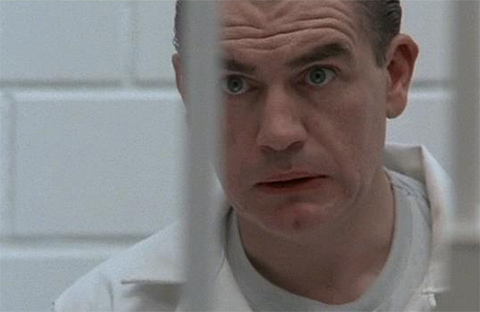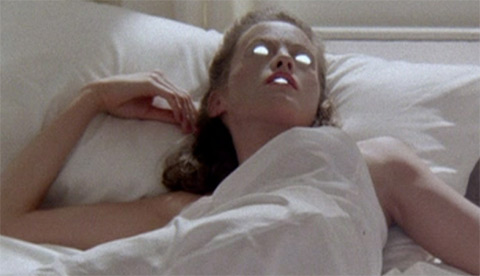Month of Horrors / Hell is Adaptations: Manhunter

Watching Michael Mann’s Manhunter is something like watching a now-famous actor in a commercial filmed at the beginning of his career; except that here the actor is a character, and the character is Dr. Hannibal Lecter. Yes, this year’s Month of Horrors will feature a crossover with our Hell is Adaptations series in an overview of all the films adapting the Hannibal Lecter novels.
What is especially noticeable to fans of later Lecter films is the scarcity of the popular cannibal in this 1986 crime thriller. It seems a little silly to assume that anybody would need an introduction to the character of “Hannibal the Cannibal,” but perhaps a quick overview is in order for the few newcomers. Originally created for Thomas Harris’ 1981 crime novel Red Dragon, Dr. Hannibal Lecter is an extremely intelligent serial killer from Eastern Europe who ate his victims and avoided detection and arrest for many years before being caught almost by chance by FBI agent William Graham, a man who has the ability to empathize with killers and figure them out from the inside. Dr. Lecter worked both in an emergency room and later as a psychiatrist, and used his medical knowledge to commit and hide his violent crimes. In many of the media adaptations of the Lecter novels, the cannibal doctor often serves as a guide to help the FBI apprehend other serial killers, though usually with the intention of playing both sides of the game.
In Manhunter, though, Hannibal Lecter is hardly to be seen. Neither, for that matter, is the eponymous serial killer Red Dragon given much time on screen. Director Michael Mann is known for his rather bombastic but stylish action films like Heat, The Last of the Mohicans, Collateral, and Public Enemies, none of which are particularly subtle examinations of the disturbed human psyche. And in that regard, Manhunter is no different than the rest of his work. Filmed in loud, gaudy colors and frequently drowned out by a synth score and an overly earnest 80s soundtrack, the 1986 adaptation is mostly about the angst of an FBI investigator who simply wants to find the bastard who’s been killing families across the country.

“That’s it, I’m eating my interior designer.”
Which brings us back to our protagonist, Will Graham. In the process of apprehending Dr. Lecter, the educated cannibal managed to cut Graham with a linoleum knife, nearly disemboweling him. Graham is so traumatized by this experience that he retires to Florida with his wife and son (his stepson, in the novel). His old boss Jack Crawford drags him back into serial killer catching rotation with a none too subtle guilt trip, and soon Graham is on the trail of the murderous Tooth Fairy, so called because the killer leaves bite marks on his victims. Graham makes a visit to Dr. Lecter in a hospital for the criminally insane, to get himself back in the swing of things. Unfortunately, this visit also revives Lecter’s hatred of the man who imprisoned him, and takes the opportunity of Graham’s request for assistance to tip off the Tooth Fairy to the agent’s plans and weaknesses.
Lesson to be learned? Never trust a psychopathic cannibal.
Lecter (spelled “Lecktor” in this film) is here portrayed all too briefly by the Scottish actor Brian Cox, known for his roles in The Bourne Identity, 25th Hour, and Adaptation. Cox only has a few minutes of screen time, but he successfully chews the institutional scenery as an erudite fop for the short time he appears. The character actually has quite a larger role to play in the novel, not just in terms of action, but as a sort of overbearing Greek Chorus, forever commentating upon Graham’s investigation and mental state. It’s a pity he’s short-shrifted in Manhunter, but Hollywood would more than make up for it with the later Silence of the Lambs.

“I chewed this scenery with a nice Chateau Peymouton and some lima beans.”
Tom Noonan (Heat, Synecdoche, New York) portrays Francis Dolarhyde, the serial killer at large, known first as The Tooth Fairy, and later by his chosen name, Red Dragon, which takes its inspiration from the William Blake watercolor painting The Great Red Dragon and the Woman Clothed in Sun. He does a great job with the role, but unfortunately his character has little to do in the film but give Graham something to be angsty about. The novel expounds upon the character at some length, and Harris’ psychology behind Dolarhyde’s crimes is arguably more believable than that he assigns to Dr. Lecter. There is a great deal of symbolism that is also lost with the trimming of this character, and while the film may not suffer for this if one is content to view it simply as a crime thriller, it certainly loses much from the larger perspective of what Harris was trying to accomplish in the source material.
In spite of all this, there’s plenty to enjoy in Manhunter. Even though the color palette is indeed gaudy and the music overbearing, the visuals are rich and frequently even surreal. The film is a pleasure to look at, even when the design choices make little sense. Lecter’s cell is as white and barren as the hospital director’s office, and, most strangely, Jack Crawford’s FBI offices. This is a far cry from the stylized grime that Anthony Hopkins would later inhabit, but it is fascinating in its own way. The lighting is often intense, but occasionally and surprisingly subtle. At times the film is sped up or slowed down, and sometimes frames are simply removed from scenes, probably to suggest a sense of mental instability.

“And that’s when things got weird.”
While Manhunter cannot be described as a Horror film in any meaningful sense of the word, it is important to the larger discussion of the Hannibal Lecter film franchise. Even the psychological horrors that Will Graham inflicts upon himself in order to catch serial killers are scarcely given proper development. When he returns to his family at the end of the film, he seems fully recovered, if a bit sad. In the novel he has been stripped of hope and brought low, having finally “understood murder uncomfortably well.” Mann’s adaptation not a terrible one, but it would certainly be unacceptable for a director to try something like it today. Hannibal Lecter now demands a certain aesthetic, and five years after Manhunter was the first time he would receive it.
Coming Soon: The Silence of the Lambs!
 Rent Manhunter from Amazon Instant Video
Rent Manhunter from Amazon Instant Video



















 Full Details
Full Details


No comments yet.
Sorry, the comment form is closed at this time.